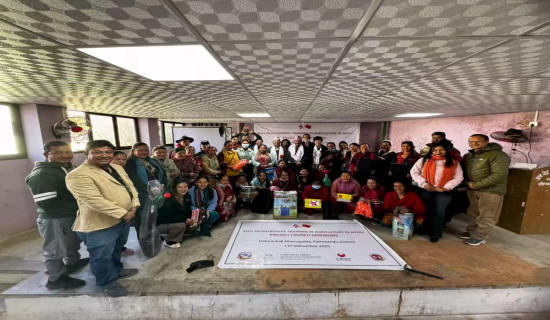- Friday, 12 December 2025
Resolving Urbanisation Anomalies
Urbanisation is taking place all over the world but the main point is how to halt haphazard and unplanned urbanisation. Like in the rest of the world, Nepal is also experiencing urbanisation rapidly. During the 1950s, there were just ten municipalities in the country. Out of these municipalities, five were in the Kathmandu Valley. At the time, most of the people were living in mountainous areas. With the passage of time, new cities emerged, mainly in the Terai belt with the eradication of malaria. The establishment of the new cities led to widespread deforestation. At the same time, the government initiated the first periodic plan (1956-61) and included, among others, planned resettlement and urban development programmes in the plan. This trend continued till the sixth periodic plan (1980-85).
The number of municipalities reached 16 in 1961. The number increased to 23 in 1981, 33 in 1991, 58 in 2001 and 191 in 2014. The number of municipalities increased further in 2015 when the government declared an additional 26 municipalities, increasing the number to 217. With this, the urban population also increased to 42 per cent of the total population. Now, there are six metropolitan cities, 11 sub-metropolitan cities, 276 municipalities and 460 rural municipalities. As per the census of 2021, the urban population is 66.08 per cent of the total population as against 63.19 per cent in 2011.
Migration
The emergence of urban areas may be attributed mainly to migration of people from rural areas. Rural folks tend to migrate to city areas like Kathmandu for better opportunities. Likewise, hilly people have a tendency to migrate to the southern plains in search of better prospects. Migration was limited during the Panchayat regime. With the restoration of multiparty democracy in the country in the early 1990, migration gradually increased. During the Maoist insurgency (1996-2006), a large number of rural people migrated to Kathmandu and other cities for security reasons. This trend has not decreased yet. Now, Kathmandu has been a melting pot, with people from outside the Valley swarming it. Even people come to Kathmandu from other parts of the country for begging!
It is said that the government declared more and more municipalities in consideration of revenue. Residents of municipalities have to pay more tax than their counter parts in rural municipalities. While declaring urban areas, the population is taken as the criteria. Metropolitan cities have over 500,000 people, sub-metropolitan cities over 200,000 people, municipalities over 10,000 people and rural municipalities fewer than 10,000 people. Physical infrastructure and service facilities, which are more important, are not taken into consideration. That is why, most of the 276 municipalities are practically rural areas. Facilities and services required for the declaration of urban areas are lacking in most of them. They lack black-topped roads, 24-hour supply of electricity, drinking water, draining and sanitation facilities, public transport systems and solid waste management systems.
Further, even metropolitan cities lack metropolis-level facilities and services. For example, Kathmandu, the biggest metropolis in the country, lacks 24-hour supply of water. If anything, there is a shortage of drinking water now. The supply of electricity is erratic. There are problems with drainage and sanitation. During the rainy season, drainage systems fail to function properly, resulting in waterlogging in various places of the capital city. In fact, Nepal is experiencing unplanned urbanisation. This has resulted in encroachment of public lands, forests and river banks, emergence of slum areas, pollution, environmental degradation, traffic congestion and so on. The landless squatters, locally called sukumbasis, occupying riverside and other areas illegally has been a problem for years.
With burgeoning urbanisation, Nepal is undergoing economic poverty, hydro-meteorological risks and climate change risks. The government needs to develop physical infrastructure and adopt digital technology and innovation. The government should also pay heed to effective public service delivery, energy requirements, environmental factors and the like.
After the promulgation of the Constitution of Nepal in 2015, the wgovernment assigned the task of managing urban development to the three tiers of government – federal, provincial and local. And through the 2016-17 budget announcement, the government announced an ambitious plan of creating ten smart cities. The definition of a smart city may not be universal but as per the government, a smart city is equipped with internet and ICT (information, communication and technology) in e-commerce, systematic public transport systems and urban infrastructure services – drinking water, electricity, drainage systems, telephone services and so on.
Smart cities
Under the concept of smart cities, the government is supposed to adopt green technology for planning urbanisation, energy, solid-waste management and sanitation. Popular participation occupies centre stage in smart city planning. So popular participation is ensured during the preparation, management and implementation of urban plans to make them effective so that a safe environment can be created and the quality of life of the people can be enhanced. The concept of smart cities envisions sustainable urban development with a focus on four components: smart people, smart governance, smart infrastructure and smart economy. However, progress towards creating smart cities is snail-paced. Rather than creating smart cities, the government should first systematise the existing cities and rural areas.
Haphazard urbanisation has thrown up formidable challenges. The government should take into account various factors such as proper land administration and relevant policies regarding it, physical and digital infrastructure to manage the existing cities and formulation of in-built contingency plans. Good urbanisation entails physical, social and digital infrastructure, proper drainage and sanitation systems, reliable public transport systems, adoption of sophisticated information and technology, disaster management systems and so on. It is the bounden duty of the government to make both urban and rural areas livable places by providing necessary facilities and services so that its presence can be felt everywhere.
(Maharjan has been regularly writing on contemporary issues for this daily since 2000.)

















